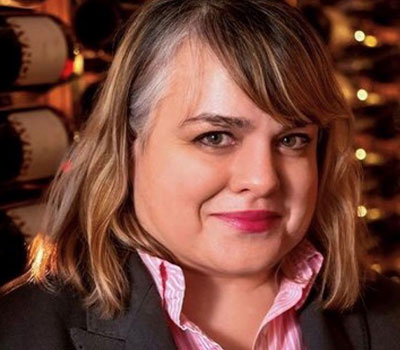Amy Mitchell came to New York in 2001 and started studying wine in 2006. She split time on the floor as a somm and captain at Indian Accent, the fine-dining restaurant in the Thompson Hotel just south of Central Park. She stepped into the Beverage Director role in 2021. —Corey Warren


Last year, many of our respondents were besieged by supply chain issues and staffing shortages. Have you found that either of these issues have improved?
I think it was significantly less impactful. Of course, we’re running out of Sancerre, but that’s not the supply chain. That was the vintage. For staffing, that’s still difficult…we’ve recently hired some more people, so it’s improving but we’re just short on numbers to be open for all the days that we want to be open for. We’re still only open six days a week. Before the pandemic, we were seven days a week, two shifts a day. Now we’re just open for dinner, six days a week. We’re hoping to go back to more shifts. Shortages are still a struggle, but it’s improving.
Wine sales decreased as a share of total sales compared to 2021. Are people drinking differently? Drinking less?
I think they’re drinking more spirits. More cocktails. It’s the guest coming and ordering differently. A lot of our regulars haven’t returned yet. We’re seeing new people, which is wonderful. With the pandemic, I think people educated themselves on spirits a lot more. Tequila really skyrocketed during the pandemic. I’m seeing a lot of people very knowledgeable about spirits, ordering spirits and sticking with cocktails or spirits for the entire meal.
You estimated that 70 percent of guests order wine with dinner, about 50 percent of them ordering reds. How do you go about selecting reds to match the cuisine?
Generally, white is a better fit for the food. It’s more versatile. But many people don’t drink white, and they want red.
Usually, Beaujolais is a nice pairing. Especially if they’re having a lighter dishes like scallops with a cauliflower and saffron curry. Then there are the richer dishes, like chicken malai tikka (chicken meatballs in green-chile cream sauce with morels and shaved truffle). It’s very decadent, so the texture is really nice with the ripe tannins of California cab. When people are looking at cabs, I can say, “Yeah, go for it!”
If people are looking for a lighter-style red and I take them to the cabernet Pfeffer from Hammerling. It’s nice and light. That can even go well with the seafood. Or to match the spices in the chaat masala with tofu, shishito peppers and onions, I can take them to Spain—mencía or a Rioja. The oxidative notes work well, it’s really savory and warming.
You also had a Stein Blauschiefer riesling. Riesling’s often named as a good pairing to South- and Southeast-Asian cuisines. Are guests coming ready to order that, or do you steer people in that direction?
A lot of times, guests are looking for it. Generally, I’ll steer them to an aromatic variety like riesling, chenin blanc or viognier because it’s versatile with the food. A lot of times before the pandemic, people were not so keen on rieslings because they thought it was too sweet, regardless of its dryness or sweetness. They’d assume it’s sweet. That was a prejudice people had against riesling. Now there’s been a shift where people are willing to consider wines with a touch of sweetness. People are more interested in pairing with the food. Before, they were almost militant about dryness. “I will not tolerate anything with RS,” or “It has to be red.” People are asking for that sweetness now, after the pandemic. More people are drinking Champagne, too. I’m seeing a huge shift in that. More people are willing to order a bottle to go through their whole meal, which is exciting for me.
You also had some staff support for the Teutonic riesling from Willamette—is this in a similar vein? Do you approach the New World riesling differently than Mosel?
It’s different. It’s a fuller-bodied, dry example, with peach, petrol, citrus and floral flavors. It’s really pretty. It also has this funny label based off of a childhood drawing of the winemaker’s…he got in trouble when he was a boy when he was asked to draw a picture of what Thanksgiving meant to him. He drew these cornucopia things with Martians falling out. It’s this really funny label. When people order it, they’ll often take pictures of the label.
What kind of Champagne?
I have both grower and big houses. A lot of times, people will order by the price point. Some of my growers are at a nice, friendly price point. I have the 2012 Gatinois for $165 on the list. And I think for a vintage 2012, that’s a nice friendly price. I have Laherte Frères for $120. I think a lot of times, people order by price point. But people ask me for advice as well. When people ask me for advice, they’re often willing to go with something they haven’t tried before, like a grower Champagne.
Do you keep any demi-sec Champs?
Not yet. That’s something I’d like to do in the future.
How do guests respond to the Aphros Vinho Verde Phaunus Pét-Nat Rosé? I love that wine, but it’s not the first thing that might come to mind given the price of your menu and your ambiance.
They love it. I’ve had to reorder it several times at this point. It’s something that moves. It’s a friendly price point, for $70. And I think it’s a really pretty wine. Flavor-wise, it has all that beautiful red-berry fruit. The concentration of fruit is nice for the food. I try to have enough wines in the double digits to make it inviting. That opens up the possibility of multiple bottles.
Corey Warren is the Tastings Editor in addition to covering the wines of the Loire, Southern France, Argentina and South Africa.
This is a W&S web exclusive. Get access to all of our feature stories by signing up today.


















